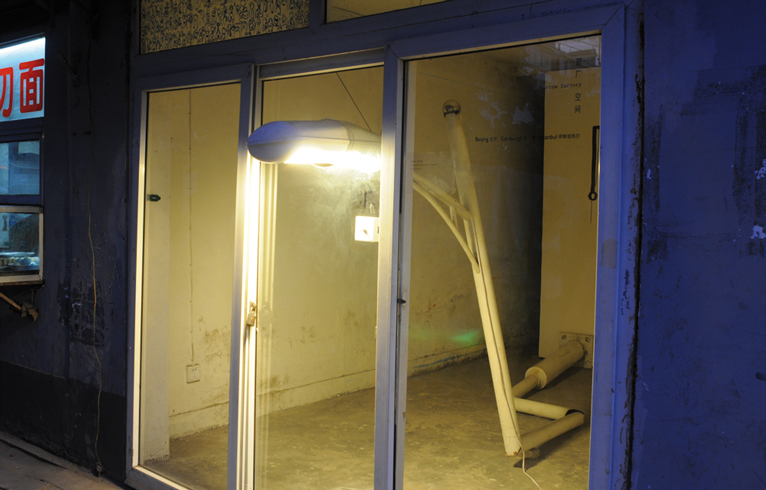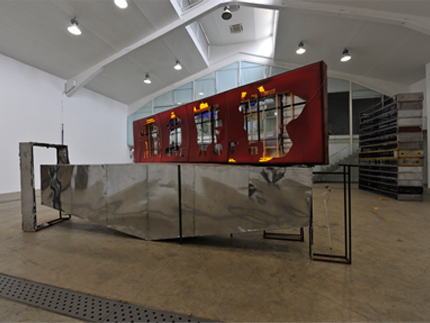HE AN
| December 23, 2011 | Post In LEAP 11

WIND LIGHT AS A THIEF | Arrow Factory, Beijing 2011.07.03-2011.09.20
I AM CURIOUS YELLOW, I AM CURIOUS BLUE | Tang Contemporary Art, Beijing 2011.07.16-2011.08.16
A MOLE ON EACH BREAST AND ANOTHER ON THE SHOULDER | Magician Space, Beijing 2011.07.28-2011.08.21
Summertime is downtime for the gallery system. There are bound to be a few inconsequential group shows, while many galleries just take a vacation, biding time before autumn. Sensing opportunity, He An planned for three separate solo shows to open in Beijing in July. And with this, the strung-out summer period was suddenly injected with a burst of enthusiasm. But is this enthusiasm a case of audience curiosity towards relay-style exhibitions, or just a part of the ripple effect caused by heavy-hitting galleries?
In the consecutive openings of three shows, with such romantic titles as “Wind Light as a Thief,” “I am Curious Yellow, I am Curious Blue,” and “A Mole on Each Breast and Another on the Shoulder,” the discriminatory sensibilities of the contemporary art system were impossible to conceal. Unsurprisingly, the Tang opening was the biggest and best-attended. In comparison with this formidable space in the main strip of 798, the other two exhibitions— one at Arrow Factory, the other at Magician Space— although both with their own objectives, seemed to be cast in mere supporting roles: an overture and an epilogue to the main act. But this may be exactly what He An was thinking, having studiously learned how to play the art world summer game.
For “Wind Light as a Thief,” a towering streetlight was bent and squeezed into the tiny Arrow Factory space, the lamp itself protruding out of the glass door onto the street and fitted with a switch freely operable by passers-by. This switch was wired into a system so that it controlled the lights of an old shop and a streetlamp next to an apartment block nearby. And vice versa: when the switch of any one of these three lights is turned on or off, the other two react accordingly.
In the sudden illumination and extinguishing of these lights, He An engendered a dialogue between complete strangers. But, just like the fallibility alluded to in the exhibition’s title, this dialogue takes the form of disturbance, or, in light of its low intensity, could admittedly be described as interference— no doubt one of the intentions of this humble space nestled in a hutong. Nonetheless the work betrays a certain desire to control. Particularly as the work itself is “hidden” within reality, it becomes not a metaphor of power but instead a conscientious mimicry of the effect of power when wielded. And on opening night, this power reared a somewhat uglier head, arousing the fierce protest of a neighborhood mother and daughter— also the wife and daughter of a well-known artist whose apartment sat right next to the streetlamp— who claimed the lights were a disturbance.
The show at Arrow Factory was in some ways a reversal of the logic of He An’s 2000 piece Miss You, Please Contact Me, in which he inscribed these titular words along with his cell-phone number in a red lightbox. This earlier piece offered the spectre of an invitation to the public, even if the interaction of individuals remained in the public sphere. He’s recent piece intended to work on a purely intimate level and to be experienced by only a few people on the street (at least during preparation, that seemed to be the case), but during the exhibition opening, the artist’s work was instead thrown straight into the public sphere. While the artist’s ceremonious intention was to lend the authorship of this piece to the outside world, in reality the inverse took place— the public were instead pulled back into the gallery, turning its enclosed space into a place of public performance, one then further dramatized and heightened in realism by the objections loudly voiced by the mother and daughter.
After taking a turn about the white cube that is Tang Space, this artist’s practice seems all the more proactive, even if the visual components of “I Am Curious Yellow, I Am Curious Blue”— lightbox illuminated phrases in Chinese, or the name of his favorite Japanese AV model Miho Yoshioka emblazoned in neon— can also be found in much of his past work. Yet in comparison to his well-known text-based lightboxes of the past, at this exhibition He does his best to avoid such overt use of this medium.

This exhibition is divided into two sections by a glass partition. On one wall rests the wreckage of the Miho Yoshioka lightbox, still flickering intermittently. This had been dropped from the top of a construction site; nearby a series of photographs document the process of its plummet to the ground. On the other side of the glass screen, the main exhibition space is of a more complex arrangement. In the middle lies another large lightbox, plugged in but completely destroyed; shards of its remains scatter the floor around it.
The wall behind this lightbox is lined with fluorescent tubes of varying lengths. Above the fluorescent tubes, which are not illuminated, are one circular blue neon light and one arc-shaped yellow neon light; on their right another wall is covered floor-to-ceiling in yellow neon lights. On their left the discarded frame of a giant light-box acts as a wall on which are hung two well-crafted and odd-looking metal frames, a white light, and a blue light; black oil drips frequently from it.
Although every individual visual component in the exhibition may be acutely minimalist in style, when encountered as a collection of objects in a space, the disparity between the two sections becomes obvious, and to interesting effect: the spectator is only able to notice this mystery when looking down at the main hall from behind the glass partition on the gallery’s mezzanine. This disparity also serves to reinforce the spatial relationships between the various components that occupy the main space, to the extent that one starts to suspect that each component actually refers entirely to some other real object, and entire exhibition begins to seem a visual reformulation of the story told by the photographs on the other side of the glass.
The third show, at Magician Space, might be taken as an example of this artist in a lighter mood: with a wall on which is written a message in Braille (identical to the exhibition’s title, seemingly made of rubber) plays a cruel joke on the gallery’s female assistant. The wall seals off the entire space, leaving her only one passage, leading to the toilet and so narrow she has to traverse it sideways. So, as the assistant squeezes past, her nipples rub against the Braille. But the value of this piece perhaps lies elsewhere, namely in its exclusion of persons larger than a certain build; it acts as a study of the relationships between body, experience and fantasy. Although this piece is perhaps excessively obscene, it nonetheless relates back to essential concerns of He’s practice. Sun Dongdong (Translated by Dominik Salter Dvorak)


